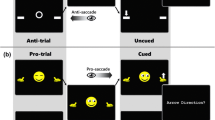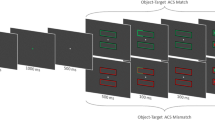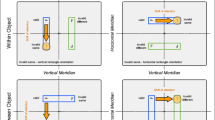Abstract
In a standard center cueing paradigm, participants are asked to identify a target object presented either to the left or the right of a center cue (e.g., eye gaze, head-turn, arrow, etc.). When the center cue is non-predictive (e.g., the arrow points to the correct location of the target only 50 % of the time), the target can still be identified faster at the validly cued location than at the invalidly cued location. However, the abrupt onset of an object can elicit reflexive attention orientation. It is important to investigate whether this abrupt onset effect interferes with the cueing effect elicited by center cues because this interference effect, if it exists, should be controlled for in order to improve the test validity of the center cueing task. In an attentional cueing paradigm, we examined how the abrupt appearance of an exogenous target object mitigates the influence of center cues involving either a head turn (Experiment 1) or an arrow (Experiment 2). In Experiment 1, a non-predictive head-turn cue was followed by a target object (circle or square) presented in the left or right visual field. In the non-distractor condition, the target object was presented by itself. In this case, it is assumed that the sudden appearance of the target provides an orienting cue to the observer. To equalize the cueing effect of the target object, we presented a competing distractor object (triangle) in the opposite visual field to the target object. The participant’s task was to categorize the target object as either a circle or square while ignoring the non-target triangle object in the opposite visual field. In Experiment 2, the arrow version of the cued recognition task was used, in which a single-headed arrow pointed to the object. The results from both experiments showed that both the non-predictive head-turn and arrow cues produced a reliable cueing effect in the distractor and non-distractor conditions. However, the magnitude of the cueing effect was greater in the distractor condition than in the non-distractor condition, suggesting that the abrupt onset of the target object acts like an exogenous signal, thereby reducing the impact of the internal head turn and arrow cues.





Similar content being viewed by others
References
Briand, K. A., Larrison, A. L., & Sereno, A. B. (2000). Inhibition of return in manual and saccadic response systems. Perception & Psychophysics, 62(8), 1512–1524.
Brignani, D., Guzzon, D., Marzi, C. A., & Miniussi, C. (2009). Attentional orienting induced by arrows and eye-gaze compared with an endogenous cue. Neuropsychologia, 47(2), 370–381.
Castel, A. D., Pratt, J., Chasteen, A. L., & Scialfa, C. T. (2005). Examining task difficulty and the time course of inhibition of return: Detecting perceptually degraded targets. Canadian Journal of Experimental Psychology/Revue Canadienne de Psychologie Expérimentale, 59(2), 90.
Chawarska, K., Klin, A., & Volkmar, F. (2003). Automatic attention cueing through eye movement in 2-year-old children with autism. Child Development, 74(4), 1108–1122.
Cheal, M., & Lyon, D. R. (1991). Central and peripheral precuing of forced-choice discrimination. The Quarterly Journal of Experimental Psychology, 43(4), 859–880.
Driver, J., IV, Davis, G., Ricciardelli, P., Kidd, P., Maxwell, E., & Baron-Cohen, S. (1999). Gaze perception triggers reflexive visuospatial orienting. Visual Cognition, 6(5), 509–540.
Eimer, M. (1997). Uninformative symbolic cues may bias visual-spatial attention: Behavioral and electrophysiological evidence. Biological Psychology, 46(1), 67–71.
Farroni, T., Massaccesi, S., Pividori, D., & Johnson, M. H. (2004). Gaze following in newborns. Infancy, 5(1), 39–60.
Friesen, C. K., & Kingstone, A. (1998). The eyes have it! Reflexive orienting is triggered by nonpredictive gaze. Psychonomic Bulletin & Review, 5(3), 490–495.
Friesen, C. K., Moore, C., & Kingstone, A. (2005). Does gaze direction really trigger a reflexive shift of spatial attention? Brain and Cognition, 57(1), 66–69.
Friesen, C. K., Ristic, J., & Kingstone, A. (2004). Attentional effects of counterpredictive gaze and arrow cues. Journal of Experimental Psychology-Human Perception and Performance, 30(2), 319–329.
Goldberg, M. C., Mostow, A. J., Vecera, S. P., Larson, J. C. G., Mostofsky, S. H., Mahone, E. M., & Denckla, M. B. (2008). Evidence for impairments in using static line drawings of eye gaze cues to orient visual-spatial attention in children with high functioning autism. Journal of Autism and Developmental Disorders, 38(8), 1405–1413.
Greene, D. J., Colich, N., Iacoboni, M., Zaidel, E., Bookheimer, S. Y., & Dapretto, M. (2011). Atypical neural networks for social orienting in autism spectrum disorders. NeuroImage, 56(1), 354–362.
Hommel, B., Pratt, J., Colzato, L., & Godijn, R. (2001). Symbolic control of visual attention. Psychological Science, 12(5), 360–365.
Hood, B. M., Willen, J. D., & Driver, J. (1998). Adult's eyes trigger shifts of visual attention in human infants. Psychological Science, 9(2), 131–134.
Johnson, M. H., Griffin, R., Csibra, G., Halit, H., Farroni, T., De Haan, M., … & Richards, J. (2005). The emergence of the social brain network: evidence from typical and atypical development. Development and Psychopathology, 17(3), 599–619.
Jonides, J. (1981). Voluntary versus automatic control over the mind’s eye’s movement. In J. B. Long & A. D. Baddeley (Eds.), Attention and performance IX (pp. 187–203). Hillsdale, NJ: Erlbaum.
Khatoon, S., Briand, K. A., & Sereno, A. B. (2002). The role of response in spatial attention: Direct versus indirect stimulus–response mappings. Vision Research, 42(24), 2693–2708.
Klein, R., Kingstone, A., & Pontefract, A. (1992). Orienting of visual attention. In Eye movements and visual cognition (pp. 46–65). New York: Springer.
Kuhn, G., & Benson, V. (2007). The influence of eye-gaze and arrow pointing distractor cues on voluntary eye movements. Perception & Psychophysics, 69(6), 966–971.
Kuhn, G., Benson, V., Fletcher-Watson, S., Kovshoff, H., McCormick, C. A., Kirkby, J., & Leekam, S. R. (2010). Eye movements affirm: Automatic overt gaze and arrow cueing for typical adults and adults with autism spectrum disorder. Experimental Brain Research, 201(2), 155–165.
Kylliäinen, A., & Hietanen, J. K. (2004). Attention orienting by another’s gaze direction in children with autism. Journal of Child Psychology and Psychiatry, 45(3), 435–444.
Langton, S. R., & Bruce, V. (1999). Reflexive visual orienting in response to the social attention of others. Visual Cognition, 6(5), 541–567.
Los, S. A. (1996). On the origin of mixing costs: Exploring information processing in pure and mixed blocks of trials. Acta Psychologica, 94(2), 145–188.
Los, S. A. (1999). Identifying stimuli of different perceptual categories in pure and mixed blocks of trials: Evidence for stimulus-driven switch costs. Acta Psycologica, 103(1), 173–205.
Lupiáñez, J., Milán, E. G., Tornay, F. J., Madrid, E., & Tudela, P. (1997). Does IOR occur in discrimination tasks? Yes, it does, but later. Perception & Psychophysics, 59(8), 1241–1254.
Marotta, A., Casagrande, M., & Lupiáñez, J. (2013). Object-based attentional effects in response to eye-gaze and arrow cues. Acta Psychologica, 143(3), 317–321.
Marotta, A., Lupiáñez, J., Martella, D., & Casagrande, M. (2012). Eye gaze versus arrows as spatial cues: Two qualitatively different modes of attentional selection. Journal of Experimental Psychology: Human Perception and Performance, 38(2), 326.
Müller, H. J., & Findlay, J. M. (1988). The effect of visual attention of peripheral discrimination thresholds in single and multiple element displays. Acta Psychologica, 69(2), 129–155.
Müller, H. J., & Rabbitt, P. M. (1989). Reflexive and voluntary orienting of visual attention: Time course of activation and resistance to interruption. Journal of Experimental Psychology: Human Perception and Performance, 15(2), 315–330.
Posner, M. I. (1980). Orienting of attention. Quarterly Journal of Experimental Psychology, 32, 3–25.
Posner, M. I., & Cohen, Y. (1984). Components of visual orienting. Attention and Performance X: Control of Language Processes, 32, 531–556.
Posner, M. I., Cohen, Y., & Rafal, R. D. (1982). Neural systems control of spatial orienting. Philosophical Transactions of the Royal Society of London. B, Biological Sciences, 298(1089), 187–198.
Posner, M. I., Snyder, C. R., & Davidson, B. J. (1980). Attention and the detection of signals. Journal of Experimental Psychology: General, 109(2), 160.
Pratt, J., & Hommel, B. (2003). Symbolic control of visual attention: The role of working memory and attentional control settings. Journal of Experimental Psychology-Human Perception and Performance, 29(5), 835–844.
Pruett, J. R., Jr., LaMacchia, A., Hoertel, S., Squire, E., McVey, K., Todd, R. D., & Petersen, S. E. (2011). Social and non-social cueing of visuospatial attention in autism and typical development. Journal of Autism and Developmental Disorders, 41(6), 715–731.
Remington, R. W., Johnston, J. C., & Yantis, S. (1992). Involuntary attentional capture by abrupt onsets. Perception & Psychophysics, 51(3), 279–290.
Ristic, J., Friesen, C. K., & Kingstone, A. (2002). Are eyes special? It depends on how you look at it. Psychonomic Bulletin & Review, 9(3), 507–513.
Ristic, J., Mottron, L., Friesen, C. K., Iarocci, G., Burack, J. A., & Kingstone, A. (2005). Eyes are special but not for everyone: The case of autism. Cognitive Brain Research, 24(3), 715–718.
Ristic, J., Wright, A., & Kingstone, A. (2007). Attentional control and reflexive orienting to gaze and arrow cues. Psychonomic Bulletin & Review, 14(5), 964–969.
Rombough, A. H., Barrie, J. N., & Iarocci, G. (2012). Social cueing elicits a distinct form of visual spatial orienting. In J. A. Burack, J. T. Enns, & N. A. Fox (Eds.), Cognitive science, development, and psychopathology: Typical and atypical developmental trajectories of attention (pp. 221–250). New York: Oxford University Press.
Rombough, A., & Iarocci, G. (2012). Orienting in response to gaze and the social use of gaze among children with autism spectrum disorder. Journal of Autism and Developmental Disorders, 43(7), 1584–1596.
Scaife, M., & Bruner, J. S. (1975). The capacity for joint visual attention in the infant. Nature, 253(5489), 265–266.
Senju, A., Tojo, Y., Dairoku, H., & Hasegawa, T. (2004). Reflexive orienting in response to eye gaze and an arrow in children with and without autism. Journal of Child Psychology and Psychiatry, 45(3), 445–458.
Shepherd, M., Findlay, J. M., & Hockey, R. J. (1986). The relationship between eye movements and spatial attention. The Quarterly Journal of Experimental Psychology, 38(3), 475–491.
Stauder, J. E., Bosch, C., & Nuij, H. A. (2011). Atypical visual orienting to eye gaze and arrow cues in children with high functioning Autism Spectrum Disorder. Research in Autism Spectrum Disorders, 5(2), 742–748.
Swettenham, J., Condie, S., Campbell, R., Milne, E., & Coleman, M. (2003). Does the perception of moving eyes trigger reflexive visual orienting in autism? Philosophical Transactions of the Royal Society of London. Series B: Biological Sciences, 358(1430), 325–334.
Taylor, T. L., & Klein, R. M. (1998). On the causes and effects of inhibition of return. Psychonomic Bulletin & Review, 5(4), 625–643.
Tipples, J. (2002). Eye gaze is not unique: Automatic orienting in response to uninformative arrows. Psychonomic Bulletin & Review, 9(2), 314–318.
Tipples, J. (2008a). Negative emotionality influences the effects of emotion on time perception. Emotion, 8(1), 127.
Tipples, J. (2008b). Orienting to counterpredictive gaze and arrow cues. Perception & Psychophysics, 70(1), 77–87.
Vlamings, P. H., Stauder, J. E., van Son, I. A., & Mottron, L. (2005). Atypical visual orienting to gaze-and arrow-cues in adults with high functioning autism. Journal of Autism and Developmental Disorders, 35(3), 267–277.
Acknowledgments
This research was supported by grants from the Chinese Scholarship Council, the Temporal Dynamics of Learning Center (NSF Grant #SBE-0542013), National Institute of Child Health and Human Development (NIH Grant HD-46526) and the Natural Sciences and Engineering Research Council. We would like to thank Kristy Mineault and Thomas Rogers for collecting the data, and Jennifer MacSween and Dr. Travis Baker for being the models in the stimulus of the Cued Recognition Task.
Author information
Authors and Affiliations
Corresponding author
Rights and permissions
About this article
Cite this article
Xu, B., Tanaka, J.W. The cued recognition task: dissociating the abrupt onset effect from the social and arrow cueing effect. Atten Percept Psychophys 77, 97–110 (2015). https://doi.org/10.3758/s13414-014-0763-7
Published:
Issue Date:
DOI: https://doi.org/10.3758/s13414-014-0763-7




